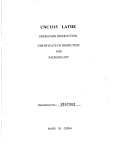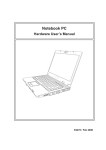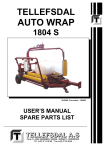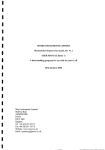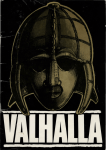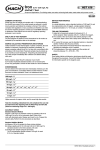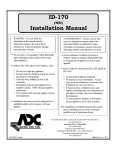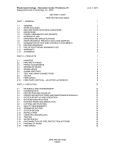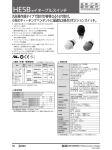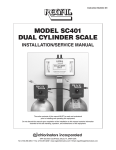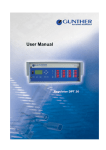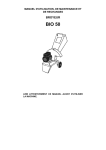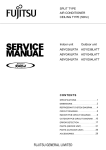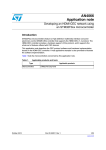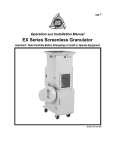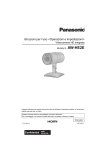Download Ball Bearings for Units
Transcript
Table of Contents Introduction ……………………….…………….………………………… 2 Ball Bearings ………………………………………………………………. 9 Roller Bearings ……………………………………………………..…….. 17 Rolling element linear bearings ………………………………………….. 23 Plain Bearings …………………………………………………….………. 25 Technical Information ……………………………………………………. 27 Bearing Units ………………………………………..……………………. 38 Introduction of KML ……………………………..………………………. 44 Copyright © 2006 KML Bearing USA, Inc. July 2006 KML Bearing USA Edition TM806 Bearing Training Manual is the initial publication. The contents of this publication are the copyright of KML Bearing USA, Inc. and may not be reproduced in part or in entirety in any form without specific written permission by the copyright owner. Every effort has been made to insure the accuracy of the information contained in this publication. KML Bearing USA, Inc. assumes no liability for any errors or omissions. The listing of products in this publication does not insure product introduction or current availability. KML Bearing USA Inc. Page 1 Introduction Friction Bearings are used to reduce friction and wear whenever relative motion exists between two parts. No bearing is completely without friction and they do wear with use, however, very little friction is produced when starting and running, and if properly installed and maintained, they can outlast the life of the driven machine. There are two types of friction: sliding and rolling Bearings can be classified as providing sliding or rolling contact. KML Bearing USA Inc. Page 2 Sliding contact bearings & rolling contact bearings Sliding contact bearings are referred to as plain bearings while rolling contact bearings are often called “anti-friction” bearings (or rolling element bearings) Bearings that provide sliding contact fall into three general classes: - radial bearings that support rotating shafts (sleeve bearings); - thrust bearings that support axial loads on rotating shafts; - linear bearings that guide moving parts in a straight line. Rolling element bearings minimize friction by removing any possible sliding between bearing surfaces and replacing all contacts with rolling interfaces. KML Bearing USA Inc. Page 3 Characteristics of plain bearings • Their resistance to shock and vibration is greater than rolling element bearings. • The hydrodynamic oil film produced by plain bearings damps vibration, so less noise is transmitted. • They are less sensitive to lubricant contamination than rolling element bearings. Characteristics of rolling element bearings • The starting friction between mating surfaces is lower and there is little difference between this and the dynamic friction produced. • They are internationally standardized, interchangeable and readily obtainable. • Maintenance, replacement, and inspection are easy because the structure surrounding rolling element bearings is simple. • Generally, many rolling element bearings are capable of carrying both radial and axial loads simultaneously or independently. • May be used under a wide range of temperatures. • Bearing rigidity can be improved by preloading. KML Notes KML Bearing USA Inc. Page 4 Bearing Construction and Nomenclature • • • Rolling element bearings consist of two rings (an inner ring and an outer ring), rolling elements and a retainer. The rolling elements are placed between the two rings and are kept equally spaced from each other by the retainer. This construction provides the bearings with smooth rolling movement. KML Bearing USA Inc. Page 5 Load Orientation – Terminology There are two basic loads in bearing application. o Radial loads. Radial loads refer to loads acting perpendicular to the centerline of the shaft; o Axial or thrust loads. Axial loads is loads acting parallel to the centerline of the shaft; In most situations, bearings are subjected to combined loads. Combined loads are comprised of both radial and axial loads acting simultaneously. Bearings which are chiefly used for radial loads are referred to as radial bearings. They have a nominal contact angle α 45º. Thrust bearings refer to bearings which are chiefly used for axial loads. They have a nominal contact angle α 45º. Radial Thrust KML Bearing USA Inc. Page 6 Rolling elements • • Rolling elements come in two general shapes: balls and rollers Rollers come in four basic styles: cylindrical, needle, tapered and spherical a) b) c) d) e) f) Ball Cylindrical roller Needle roller Tapered roller Symmetrical spherical roller Unsymmetrical Spherical roller Needle rollers have a much smaller diameter-to-length ratio than cylindrical rollers.The diameter of needle rollers is usually less than ¼" in diameter. The length of a needle roller can range from 3 to 10 times its diameter. KML Notes KML Bearing USA Inc. Page 7 Classification of rolling bearings Rolling bearings Ball bearings Roller bearings Radial ball bearings Thrust ball bearings Radial roller bearings Thrust roller bearings Deep groove ball ball bearings Angular contact ball bearings Self-aligning ball bearings Four point contact ball bearings Insert ball bearings Cylindrical roller bearings Needle roller bearings Tapered roller bearings Spherical roller bearings Cylindrical roller thrust bearing Needle roller thrust bearings Tapered roller thrust bearings Spherical roller thrust bearings Ball bearings and roller bearings • Ball bearings exhibit a lower frictional resistance and lower face run-out in rotation than roller bearings. • Ball bearings are more suitable for use in applications which require high speeds, high precision, low torque and low vibration; • Since the rolling elements in roller bearings make line contact with raceways, roller bearings have a larger load carrying capacity that makes them more suitable for applications requiring long life and endurance for heavy loads and shock loads. KML Bearing USA Inc. Page 8 Ball Bearings Single Row Deep Groove Ball Bearings (SRDG) Single row deep groove ball bearings are the most commonly used bearings and the most popular type for all ball bearing applications. Deep groove ball bearings are suitable for high-speed applications. Somewhat self-aligning, deep groove ball bearings allow a minor misalignment (1/6 degrees) without affecting the bearing operation and life. Deep groove ball bearings meet diverse application requirements: open type, prelubricated, with one or both sides sealed or shielded or with snap rings, etc. KML bearings construction code: NR: with snap ring ZZ: with double shields 2RS: with double non-contact seals 2RD: with double light contact seals 2RK: with double contact seals These are sometimes called Conrad bearings. They are assembled by offsetting eccentrically the inner and outer rings to allow the insertion of balls (see figure above). The Conrad bearings therefore have uninterrupted ringways (no filling slot) which permits excellent bearing performance under light to moderate radial loads, relatively moderate axial loads, or combined radial and axial loads. KML also has cartridge type deep groove ball bearings which have the same standard bore and O.D. as single row deep groove ball bearings, but are as wide as double row ball bearings. They are supplied with two seals or shields and contain a large grease capacity found useful in extremely dirty and dusty conditions. KML Bearing USA Inc. Page 9 Bearings: Sealed and Shielded Sealed Bearings The construction of these bearings is shown below. It has a flexible nonmetallic member secured to the outer ring and makes a light contact on the inner ring. Advantages: 1. Entry of contaminants is less likely than open bearings. 2. No regular relubrication is necessary nor possible. Disadvantages: 1. 2. 3. 4. The bearing life is restricted to the lubrication packed between the seals of the bearings. Sizes available are restricted due to the excessive heating on larger sizes. Maintenance requires replacement of the bearings. Higher Friction Losses. KML Bearing USA Inc. Page 10 Shielded Bearings Shielded bearings are also a variation of the Conrad bearings and are very similar to the sealed type bearings except that the shielded bearings have metallic rather than non-metallic shields. The metal member is secured to the outer ring with a close running clearance to the inner ring. Shielded bearings can be relubricated. Advantages: 1. Retains the lubricant at the rolling elements regardless of the chamber fill. 2. Provides relubrication to the balls by the slinger feeding of inner ring. 3. Eliminates large particles from getting into the rolling elements at installation and in operation. 4. Higher Friction Losses over open but typically less than Sealed Bearings. Disadvantages: Excessive pressure with no relief provided can force the shields against the cage or balls, thereby, eliminating regreasability or causing immediate failure. KML Bearing USA Inc. Page 11 Angular Contact Ball Bearings (ACBB) Angular contact ball bearings are designed to support axial loads in one direction or axial loads combined with radial loads. Contact angle: the angle between the line connecting the contact points of the ball and the inner ring and the ball and the outer ring, and the line drawn in the radial direction. Angular contact ball bearings have contact angles of 15º, 25º and 40º identified by suffix C, A and B respectively. Angular contact ball bearings with the larger contact angles tolerate heavier axial loads. Angular contact ball bearings have increased thrust capacity over Conrad bearings. Thrust must be in the direction of the thrust shoulder. Thrust in an opposite direction can drive balls over the counter-bore shoulder or cause ball damage, and failure. These bearings can be mounted singularly or, when the side surfaces are flush ground, in multiple, either face-to-face or back-to-back for all combinations of thrust and radial loading. Flush ground bearings can also be tandem mounted to permit sharing heavy thrust loads in one direction among two or more bearings. KML Bearing USA Inc. Page 12 Duplex angular contact ball bearings a) Tandem Mounting (DT) Can accommodate radial and single direction axial loads. Can accommodate heavy axial loads as axial loads are received by both bearings b) Back-to-back Mounting (DB) o Can accommodate radial loads and axial loads in either direction. o Has a large distance between the acting load center of the bearing, and therefore a large moment capacity. o Allowable misalignment angle is small. c) Face-to-face Mounting (DF) Can accommodate radial loads and axial loads in either direction. Has a smaller distance between the acting load center of the bearing, and therefore a smaller moment capacity. Has a larger allowable misalignment angle than back-to-back type. KML Bearing USA Inc. Page 13 Double row angular contact ball bearings The structure of double row angular contact ball bearings is designed by arranging two single row angular contact ball bearings back-to-back (DB) to form one united bearing with a contact angle of 25º. They have the same characteristics as duplex angular contact ball bearings (DB), while having smaller width. They are suited where axial space is limited. For high speeds or high accuracy requirements, double row angular contact ball bearings are not as good as single row or duplex angular contact ball bearings KML Shielded and sealed type double row angular contact ball bearings are also available. KML Notes KML Bearing USA Inc. Page 14 Thrust Ball Bearings Thrust ball bearings ordinarily have a 90º contact angle. Thrust ball bearings are divided into single direction and double direction type. The former only supports axial loads in one direction, while the latter supports axial loads in both directions. Thrust ball bearings permit only axial loads, and they are not recommended for high-speed applications. Single direction thrust ball bearings (51000 series) Double direction thrust ball bearings (52000 series) KML Bearing USA Inc. Page 15 Self-Aligning Ball Bearings Self-aligning ball bearings, with two rows of balls rolling on the spherical surface of the outer ring, compensate for angular misalignment resulting from errors in mounting, shaft deflection, or distortion of the foundation. It is impossible for these bearings to exert any bending influence on the shaft. The permissible misalignment of self-aligning ball bearings is approximately 3º under normal loads. It is a very important consideration in many applications requiring extreme accuracy, at high speeds. Self-aligning ball bearings are recommended for radial loads and moderate thrust loads. KML self-aligning ball bearings with tapered bores (1:12) are also available. KML Bearing USA Inc. Page 16 Roller Bearings Cylindrical Roller Bearings Cylindrical roller bearings can accommodate more radial loads (approximately 2 to 3 times) than ball bearings. Ordinarily they are unable to accommodate even the slightest axial loads. Some types which have ribs on the outer ring and the inner ring can receive axial loads. The rollers are guided by ribs on either the inner or outer ring, therefore cylindrical roller bearings are more suitable for high-speed applications. Cylindrical roller bearings are separable and relatively easy to install and disassemble even when interference fits are required. Cylindrical roller bearings types: NU NJ KML Bearing USA Inc. N NF NH NUP Page 17 Double row cylindrical roller bearings are also in use. NN 0000 K NNU 0000 K NNU 0000 The permissible misalignment varies depending on the type and internal specifications. Under normal loads, the misalignment angles are approximately as follows: For width series 0 or 1: 2´ For width series 2: 4´ KML Notes KML Bearing USA Inc. Page 18 Tapered Roller Bearings A large variety of tapered roller bearings, including single, double and four row arrangements are in use both in metric and inch system sizes. Tapered roller bearings can be disassembled into parts: Inner ring, rollers, cage (collectively called as the “cone”) Outer ring (called as the “cup”) Subunit dimensions are standardized, therefore, they are interchangeable within each dimensional standard. However, high precision grade bearings are generally not interchangeable. Tapered roller bearings have a high capacity for radial loads, axial loads, and combined loads. The larger the contact angle, the greater the axial load capacity becomes. The cone and the cup are separable, enabling them to be installed with the desired interference fits. Double row (35000 series) KML Bearing USA Inc. Four row (38000 series) Page 19 Spherical Roller Bearings Spherical roller bearings have self-aligning properties. They are suitable for applications where misalignment between the inner and out rings occurs from housing installation error or shaft flexure. Spherical roller bearings have a large capacity for radial loads, axial loads in either direction, and complex loads. They are also suited for use where vibration and shock loads are encountered. It is possible to provide an oil groove and holes in the out ring to supply lubricant (with code W33). The permissible misalignment varies depending on the size and loads, but it is approximately 1º to 2.5º with average loads. In addition to spherical roller bearings with cylindrical bore diameters, those with tapered bore diameters are also available at KML. The suffix “K”: taper ratio 1:12 for bearings with tapered bores; The suffix “K30”: taper ratio 1:30 for bearings with tapered bores; KML Bearing USA Inc. Page 20 Needle roller bearings Needle roller bearings are bearings with rollers that have high length-to-diameter ratios. Compared with other roller bearings, needle roller bearings have much smaller rollers for a given bore size. Needle roller bearings have the highest load capacity for a given radial space of all rolling element bearings. All needle roller bearings are variations of two basic designs. Loose - needle bearings are simply a full complement of needles in the annular space between two hardened components and contain no retainer. Needle rolling bearings provide an effective and inexpensive bearing assembly with moderate speed capability, but they are sensitive to misalignment. Caged needle bearings are simply a roller complement with a retainer or cage for roller guidance and spacing. Their speed capability is about three times higher than that of loose needle bearings, but the smaller complement of needles reduces load capacity. Needle roller bearings have the advantage of a higher speed capacity; also they have greater lubricant capacity. Needle roller bearings are mainly classified into four types shown below. Needle roller and cage assemblies (K type) Needle roller bearings with inner ring (type NA, NK1) Needle roller bearings without inner ring (type RNA, NK) Drawn cup needle roller bearings without inner ring (type HK, BK) K KML Bearing USA Inc. NA, NK1 RNA, NK HK, BK Page 21 Roller Thrust Bearings Roller thrust bearings include spherical roller thrust bearings, cylindrical roller thrust bearings, tapered roller thrust bearings and needle roller thrust bearings. Spherical roller thrust bearings combine a very high load-carrying capacity (heavy axial loads or combined loads which are predominantly axial) with a self-aligning capability and can operate at relatively high speeds under heavy loads. Cylindrical roller thrust bearing, tapered roller thrust bearings and needle roller thrust bearings can sustain only axial loads. KML Bearing USA Inc. Page 22 Rolling element linear bearings Most rolling element bearings are in use for rotating or oscillating loads, but there are also bearings designed for linear motion. Rolling element (ball or cross roller) linear bearings are widely employed in the precision tables today. Rolling element linear bearings are grouped into two primary categories: recirculating rolling element linear bearings, and nonrecirculating rolling element linear bearings. Recirculating rolling element linear bearings, which are sometimes called recirculating ball bushings, facilitate very long travel distances. These ball bushings have several rows of recirculating balls (balls circulate in a loop, each set in their own track), which support the moving carriage and permit very long travel lengths. The ball bushings provide good load capacity with very low friction (the coefficient of friction can be as low as 0.001) and its modular design permits easy replacement of bearing components. To minimize installation time and cost, the ball bushings can be mounted in industry standard pillow blocks. The closed type and open type pillow blocks are available. The closed type is used in end-supported applications for spanning or bridging a gap. While the open style is used for continuously supported applications when maximum rigidity and stiffness is required. KML Bearing USA Inc. Page 23 Linear guides Another rolling element linear bearings are linear guides. Linear guides are roller guides which utilize balls and are used for supporting load and guiding precise linear motion with low friction. Linear guides are comprised of a rail and ball slide. The balls roll on the grooves on the rail and the ball slide, and are collected by the end cap. The end cap is attached to the end of the ball slide. Then the balls go through the opening made in the ball slide, and circulate back to the other end. Characteristics of linear guides: o High precision and quality; o High reliability and durability; o High load carrying capacity (shock-resistance); They can be used in Machine tools because of their high accuracy, high load capacity, high speed, smooth motion, and high durability. Also they can be used in Carriers, handling robots, and injection Molding machines, etc. Below is an example used in high accuracy positioning tables. KML Bearing USA Inc. Page 24 Plain Bearings Lubrication There are three types of lubrication in plain bearings. o Boundary lubrication - bearing and shaft surfaces rub together with only a thin film of lubricant separating them. Grease-lubricated bearings generally operate with a boundary film. o Mixed-film lubrication - bearings support part of the loads on a boundary film where the shaft is closest to the bearing. The remainder of the loads is supported by hydrodynamic, or full-film, lubrication. o Full-film or hydrodynamic lubrication - the shaft is separated from the bearing by a continuous film of self-pressurized lubricant with no metal-to-metal contact. This fluid film is generally about 0.001 in. thick, but films as thin as 0.0005 in. are sufficient if shaft surface finish is held within 10-µm. RMS and bearing inner surface is held to 30-µm. RMS maximum. In many situations, the bearing itself contains or acts as the lubricant. Because most applications exhibit less than full-film lubrication at least occasionally, a bearing of proper material and design must be selected to ensure satisfactory operation. Bearings operating with full-film lubrication typically exhibit a coefficient of friction between 0.001 and 0.020, depending on mating surfaces, lubricant, clearances, and speed. For a mixedfilm bearing, the coefficient ranges between 0.02 and 0.08, and for boundary-lubricated bearings, between 0.08 and 0.14. The coefficient of friction in a bearing application is important because the higher the coefficient of friction, the higher the heat generation. Excessive heat reduces life of the bearing. Excessive heat may also cause expansion of the shaft, housing, or bearing, or any combination of these. This expansion reduces the clearance between the shaft and bearing, further increasing operating temperature, resulting eventually in premature bearing failure. Materials Many metallic, nonmetallic, and compound materials are available. Bronze has probably been the most familiar plain bearing material because a variety of characteristics can be imparted to it by adding other metals. In general, softer materials are used for lighter loads and higher speeds; harder materials for higher loads and lower speeds. Metallic - The softest metallic bearing materials are babbitts. Babbitts have been widely used as bearing materials for years. In terms of increasing hardness, the next material family is bronze alloys, such as Tin bronze, Manganese bronze, Aluminum bronze, sintered bronze, etc. They serve from very high-speed, light-load uses to very light-speed, high-load uses. KML Bearing USA Inc. Page 25 Zinc-aluminum alloys have emerged in recent years as a cost-effective alternative to bronze alloys; however, successful application of zinc-aluminum alloys is restricted primarily to highload, low-speed applications. Nonmetallic - Nonmetallic or self-lubricating bearings often require no liquid lubricant. Selflubricating bearings are most effective in applications where relative motion is not sufficient to circulate oil or grease required for metallic bearings. Self-lubricating bearings are also used for temperatures beyond the scope of conventional lubricants. These temperatures may range from 400 to 750°F or higher. Self-lubricating bearings are especially well suited for corrosive environments. The coefficient of friction of self-lubricating bearings running completely dry generally ranges from 0.1 to 0.4. Thus, Friction limits the application of self-lubricating bearings. The most common self-lubricating materials include polytetrafluor-oethylene (PTFE), graphite, and molybdenum disulfide (MoS2). Spherical plain bearings Spherical plain bearings have the inner and outer rings making contact with each spherical surface and can take a large radial load and two directional thrust load at the same time. Spherical plain bearings are basically divided into steel-on-steel and maintenance-free types according to the kind of sliding surface. 1. The steel-on-steel type have inner and outer rings of high carbon chromium bearing steel and the sliding surface has been phosphate-treated, and is dry-coated with molybdenum disulfide (MoS2). They can, therefore, operate with low torque, and have excellent wear resistance properties and a large load rating. They are especially suitable for applications where there is alternate load and shock load. 2. The maintenance-free type is a combination of an outer ring which has a spherical PTFE sheet fixed on the sliding surface, and a spherical inner ring whose sliding surface has a hard chromium plating. They have a long life and can be used for extended periods of time without re-lubrication. They are especially suitable in cases where fixed directional loads are to be taken and are used mainly in foodprocessing machines and construction machinery and other fields where the use of oil is undesirable and where lubrication is not possible. KML Bearing USA Inc. Page 26 Technical Information Bearing numbers Rolling bearing numbers are comprised of “basic numbers” followed by “supplementary symbols”. The basic numbers indicate the bearing type, the width series, diameter series (outer diameter dimensions), bore diameter and contact angle. The supplementary codes derive from prefixes and suffixes which identify detail characteristics of the bearings such as tolerances, internal clearances, seal or shield specifications, etc. Bearing type code o o o o o o o o Deep groove ball bearings: 6 Angular contact ball bearings: 7 Self-aligning ball bearings: 1, 2 Cylindrical roller bearings: NU, N, NF, NNU, NN, etc. Tapered roller bearings: 3 Spherical roller bearings: 2 Cylindrical roller thrust bearings: 8 Thrust ball bearings: 5 Suffixes o o o o o NR: with snap ring ZZ: with double shields 2RS: with double non contact seals 2RD: with double light contact seals 2RK: with double contact seals Contact angle code o Angular contact ball bearings: A standard contact angle: 25º B standard contact angle: 40º C standard contact angle: 15º o Tapered roller bearings: (B) over 10 º to/including 17 º C over 17 º to/including 24 º D over 24 º to/including 32 º KML Bearing USA Inc. Page 27 Bearing number examples 6 3 0 6 ZZ C3 Radial internal clearance C3 Shields on both sides Bearing bore diameter 30mm Diameter series 3 Deep groove ball bearing NN 3 0 0 6 K C1 P4 Accuracy of ISO Class 4 Radial internal clearance C1 Tapered inner ring bore (taper ratio 1:12) Bearing bore diameter 30mm Diameter series 0 Width series 3 Cylindric roller bearing NN type 7 2 0 6 A DB Back-to-back duplex arrangement Contact angle 25º Bearing bore diameter 30mm Diameter series 2 Angular contact ball bearing KML Notes KML Bearing USA Inc. Page 28 Internal Clearance Bearing internal clearance: the total amount that one ring can be displaced relative to the other in the radial and axial directions before being installed on a shaft or in a housing The radial internal clearance and the axial internal clearance Internal clearance code: C2, (CN), C3, C4, C5 C2 - Radial clearance less than standard No suffix - Radial clearance is standard C3 - more than standard (Reliance Standard) C4 - more than C3 Radial ball bearings are usually supplied with a specified radial clearance, which will normally diminish during mounting because of interference fits with the shaft and house. After mounting, the bearing should have a small radial clearance remaining. 1) Bearings are normally a press fit on the shaft of the rotating unit. The degree of press stretches the inner ring O.D. - this can compress the balls and reduce life. 2) Heat caused by rotation can expand the balls and rings. To eliminate precompression of balls, radial clearance should be allowed. KML Bearing USA Inc. Page 29 Bearing tolerances Dimensional accuracy and running accuracy o Dimensional accuracy is related to mounting of bearings on shafts or in housings o Running accuracy is related to runout of rotating parts ISO, DIN, and JIS standardize five classes of bearing tolerances: class 0,6,5,4,2, with progressively higher degrees of precision AFBMA standards: ABEC 1, ABEC 3, ABEC 5, ABEC 7, ABEC 9 for Ball bearings RBEC 1, RBEC 3, RBEC 5, for Roller bearings Abbreviation: AFBMA - Anti-friction Bearing Manufacturers Association ABEC - Annular Bearing Engineering Committee RBEC - Roller Bearing Engineering Committee ISO - International Organization for Standardization JIS - Japanese Industrial Standards DIN - Deutsch Industrie Norm Application: AFBMA ISO ABEC-1 Application tolerances suitable for general commercial applications such as appliances, automobiles, and construction equipment ABEC-5 tolerances suitable for use in machine tools and high speed electric 5 motors. ABEC-7 for measuring and recording instruments and other precision equipment 4, 2 ABEC-9 applications. 0 KML Bearing USA Inc. Page 30 Boundary dimensions The boundary dimensions of rolling bearings, sometimes referred to as the bearing’s envelope dimensions, are the dimensions that define external geometry. They include Outside Diameter D, Inside Diameter or bore d and width B and chamfer dimension r. Bearing boundary dimensions have been standardized by the international Standards Organization (ISO). Within each diameter series there are several dimension series which are combinations of the diameter series and different width series. KML Bearing USA Inc. Page 31 Bearing Life When a number of identical bearings are operated under the same conditions of load and speed, a dispersion of their lives is observed. Basic rating bearing life is based on a 90% statistical model which is expressed as the total number of revolutions 90% of the bearings in an identical group, subjected to identical operating conditions, will attain or exceed before flaking due to material fatigue occurs. Other causes of bearing failure are attributed to problems such as seizing, abrasions, cracking, chipping, rust, etc. Since these “causes” of bearing failure can be avoided by taking the proper precautions, and are not simply caused by material fatigue, they are considered separately from the flaking aspect. Factors of lubrication, temperature, contaminants, etc., are not considered in this process. Note that bearing life is a minimum design calculation and almost all bearings will have a life exceeding this figure unless the bearing is subject to abnormal conditions. The term B10 and L10 are used interchangeably. However, L10 is the current and correct designation. The relationship between the basic rating life, the basic dynamic rating and the equivalent load is given: L10 = (Cr / Pr) L10 : Cr : Pr : p : p 6 Basic rating life in 10 revolutions Basic dynamic rating load Equivalent load =3 for ball bearings =10/3 for roller bearings KML Bearing USA Inc. Page 32 Causes Of Bearing Failures Almost without exception, the published life of a bearing is the L10 life based on the fatigue failure of rings or rolling elements. Actually, it is very unusual to find a bearing that has failed from this cause. Bearing damage type Flaking Small pieces of bearing material are split off from the smooth surface of the raceway or rolling elements due to rolling fatigue. Scoring/smearing Scoring is surface damage due to accumulated small seizures caused by sliding under improper lubrication or under severe operating conditions. Linear damage appears circumferentialy on the raceway and rolling surfaces. Cyclodial shaped damage on the roller end. Scoring on the rib surface contacting roller end. Smearing occurs from a collection of small seizures between bearing components caused by oil film rupture and/or sliding. Surface roughening occurs along with melting. Cracks Cracks can be in the raceway ring and rolling elements. Continued use under this condition leads to larger cracks or fractures. Indentations Raceways and rolling elements may become dented if the mounting pressure is applied to the wrong ring, so that it passes through the rolling elements, or if the bearing is subjected to abnormal loading while not running. Seizure When sudden overheating occurs during rotation, the bearing becomes discolored. Next, the raceway rings. The rolling elements and the cage will soften, melt and deform as damage accumulates. Electrical Corrosion When electrical current passes through a bearing, arcing and burning occurs through the thin oil film at points of contact between the race and rolling elements. The points of contact are melted locally to form ‘fluting’ or groove-like corrugations. KML Bearing USA Inc. Page 33 Corrosion & Rust Corrosion and rust are pits on the surface of rings and rolling elements and may occur at the rolling element pitch on the rings or over the entire bearing surfaces. Abnormal Wear (wear, creep, fretting) Wear is surface deterioration due to sliding friction at the surface of the raceway, rolling elements, roller end faces, rib face, cage pockets etc. Creep is a relative slipping at the fitting surfaces. It occurs in operation when the fit is not tight enough compared to the applied load. Fretting corrosion occurs when a bearing in a stationary condition is subjected to vibration or oscillation at a small angle. The most common causes of failure are as follows: Poor lubrication practices coupled with errors in specifying bearings cause 36% of premature bearing failures. While sealed-for-life bearings can be fitted and forgotten, any bearing deprived of proper lubrication will fail long before its normal service life. Wherever manual maintenance is not feasible, a fully automatic lubrication system can be installed to lubricate a bearing with the right amount of lubricant at the correct lubrication intervals. Failure can be the result of using the wrong lubricant type, mixing lubricants, improper re-lubrication amounts, and improper additives. Premature Fatigue accounts for 34% of early bearing failures. Whenever machines are overloaded, unbalanced, or misaligned, bearings suffer the consequences. These abnormal conditions cause unintended loads on the bearing that can quickly add up to a dramatic reduction in service life. Due to overload bearings: An overloaded bearing can cause premature spalling, breakdown of lubrication, excessive heat and failure of the bearing. Such an overload can be caused by too tight a fit either on the shaft or in the housing, or by axial thermal expansion of the shaft. Due to misalignment of components: One of the great causes of premature bearing failure is misalignment between the equipment shaft and bearing housing bore. Some, but not all, bearings can tolerate minor misalignment. Serious misalignments introduce excessive vibration and loads. Poor installation accounts for about 16% of all premature bearing failures. Service personnel need to be aware of which tools to use and be trained in using them. Improper installation techniques can lead to failures from load imbalance, misalignment, or improper load distributions within the bearing. KML Bearing USA Inc. Page 34 Contamination contributes to about 14% of premature bearing failures. Bearing users have sealing solutions available that can be tailored to the most arduous operating environments. Typical failures can be the result of excessive wear, abnormal surface stresses caused by debris denting, or corrosion from liquid contamination, such as water. Other Causes of Bearing Failure There are literally hundreds of reasons bearings go bad. Although most of these problems can be spotted quickly, others are quite bewildering. At KML, we suggest detecting signs of bearing failures by monitoring noise, vibration, temperature and lubrication. Thus, the possibility of similar future failures can be reduced if all the conditions at the time of failure and the operating environment are known. KML Notes KML Bearing USA Inc. Page 35 Bearing Materials Generally, the bearing materials are required to have the following properities. 1. High fatigue strength to bear repetition of high contact loads. 2. Corrosion-resistance or heat-resistance for some application. 3. High elastic limit to withstand high localized contact stress. 4. Hardenability to ensure sufficient hardness. 5. Toughness to accept impact loads. 6. Dimensional stability. Rings and rolling element materials 1) High-Carbon Chrome Bearing Steel A large majority of rolling bearings use high-carbon chrome steel. KML specifies the chemical composition of this materical as follows. Chemical Composition of High-Carbon Chrome Steel C Mn Si Cr P S Ni Cu Mo 52100 0.98/1.10 0.25/0.45 0.15/0.35 1.30/1.60 <=0.025 <=0.025 <=0.25 <=0.35 <=0.10 GCr15 0.95/1.05 0.25/0.45 0.15/0.35 1.40/1.65 <=0.025 <=0.025 <=0.30 <=0.25 <=0.08 GCr15SiMn 0.95/1.05 0.95/1.25 0.45/0.75 1.40/1.65 <=0.025 <=0.025 <=0.30 <=0.25 <=0.08 GCr15SiMn contains large amount of manganese to improve hardenability, and is used to manufacture heavy section bearing rings. When the wall thickness of the rings required is under 17mm, GCr15 is applied, when it exceeds 17mm, GCr15SiMn is used. 2) Carburized Steel (Case Hardened Steel) Because of its combination of a hard surface layer which has been carburized and a relatively pliable inner core, Carburized Steel has excellent efficiency against shock loads. Typical Carburized Steel are chrome steel and chrome molybdenum steel. 3) Heat Resistant Bearing Steel When bearings made of ordinary chrome steel which have undergone standard heat treatment are used at temperatures above 120°C for long durations, unacceptably large dimensional changes can occur. For this reason, a dimension stabilizing treatment has been devised for high temperature applications. A variety of heat resistant steels are incorporated in bearings to minimize softings and dimensional changes when used at high temperatures, i.e. high speed molybdenum steel and high speed tungsten steel 4) Corrosion Resistant Bearing Steel For applications requiring high corrosion resistance, stainless steel is used. To achieve this corrosion resistance a large porportion of alloying element chrome is added to martensite stainless steel. KML Bearing USA Inc. Page 36 Retainer Materials As the retainer may have a substantial influence on the bearing performance and reliability, selection of its material is also important. Retainers are subdivided into pressed cages and solid cages. When compared with machined cages of metal, pressed cages are advantageous in that they are lighter in weight. Machined cages of metal are used when requirements in cage strength are strict and temperatures are high. For small and medium sized bearings, pressed cages with a low content of approximately 0.1% carbon are used, i.e. steel 08, 10, etc. For large bearings, machined cages of structural carbon steel or high tensile case brass are widely used, i.e. steel 40, 45, etc. Plastic materials may be chosen depending on application conditions, such as polyamide 66. KML Notes KML Bearing USA Inc. Page 37 Bearing Units At KML, The following types are available. Pillow blocks Flange units Take-up units Cartridge units Hanger units Methods of mounting to the shaft Set screw locking For set screw locking types, the inner ring of the bearing unit are hardened in the raceway and surrounding part where hardening is necessary, while the extended part where the set screws are installed is left metallurgically mild and tenacious. The construction of the KML “Knurled cup point set screw” is illustrated below with a pin design that prevents it from becoming loose even when it is subjected to vibrations or impact loads. To mount the set screw locking bearing unit on the shaft, it is sufficient to tighten the two set screws uniformly using a hexagonal bar wrench. Eccentric locking Collar The inner ring is fastened on the shaft by fastening the eccentric collar in the direction of the rotation of the shaft. Deformation of the inner ring seldom occurs. Eccentric locking Collar bearing unit is not recommended for applications where the direction of rotation is sometimes reversed. Tighten the eccentric collar by inserting a bar into the hole provided on the periphery of the eccentric collar and tapping the bar to turn the collar, and fasten the set screw of the eccentric collar. Adapter When an adapter bearing unit is used, there is no danger of the fit between the shaft and the inner ring working loose even if it is subjected to impact loads or vibration. After tighting the nuts, bend up the rim of the washer within the notch of the nut. This will prevent the nut from loosening. It is necessary to ensure that the nut is not over-tightened as this will deform the inner ring, causing heat generation and seizure. KML Bearing USA Inc. Page 38 Structure Grease fitting for relubrication Combination of steel slinger and steel-backed synthetic rubber seal provides the most effective sealing Single row deep groove ball bearing Fully self-aligning Rigid one-piece cast housing Specially heat-treated wide inner ring KML Bearing USA Inc. Knurled cup point set screw 120° apart Page 39 Pillow Blocks Housing type TB: Tapped base inch bolt holes PE: Standard pillow blocks AK: Lower base pillow blocks PA: Tapped base metric bolt holes PP: Pressed steel Pillow Blocks Below are some examples of pillow blocks. 1) UCPE 2) UCAK 3) UCTB 4) UCPA 5) UCPP PE TB AK PA PP At KML, we supply a large variety of Pillow Blocks such as UCPE, SBPE, HCPE, SAPE, UCAK, SBAK, HCAK, SAAK, UCTB, UCPA, HCTB, HCPA, UCPP, SBRPP, SARPP, etc. KML Bearing USA Inc. Page 40 Flange units Housing type F: Four Bolt Flange (square) FS: Four Bolt Flange (square); FS is higher than F type FC: Flange Cartridge (round) FCS: Flange Cartridge (round); FCS is smaller than FC type FL: Two Bolt Flange (rhombic) FT: Two Bolt Flange (rhombic); FT is higher than FL type FD: Two Bolt Flange (rhombic); more compact, no obvious flange LF: Two Bolt Flange (rhombic); more compact RFT: Triangle Flange FB: Three bolt Flange Bracket (offset) FK: Three bolt Flange Bracket (offset); the flange is higher than FB FA: Adjustable Flange (skewing) PF: Pressed Round Flange (round) PFL: Pressed Two Bolt Flange PFT: Pressed Triangle Flange F/FS RFT KML Bearing USA Inc. FC/FCS FB/FK FL/FT/FD/LF FA Page 41 PF PFL PFT Take-up units Housing type ST: Take-up with Wide Slot T: Take-up with Narrow Slot Cartridge units • Housing: C: Cylindrical Cartridge KML Bearing USA Inc. Page 42 Hanger units • Housing: HA: Hanger Ball Bearings for Units Bearing type: UC: Set Screw SB: Set Screw flash on one side CSB: Cylindrical Set Screw flash on one side HC: Eccentric Collar SA: Eccentric Collar flash on one side CSA: Cylindrical Eccentric Collar flash on one side UC HC KML Bearing USA Inc. SB CSB SA CSA Page 43 Bearing Units Housing Type of Mounted Bearing Units Normal Height with Reinforced Ears UCPE SBPE HCPE SAPE Low Base UCAK SBAK HCAK SAAK Tap Base UCTB UCPA Pressed Steel UCPP SBPP SAPP 4-Bolt Square Flange UCF SBF HCFS SAF 4-Bolt Round Flange with Spigot Joint UCFC UCFCS HCFC Pillow Block 2-Bolt Rhombic Flange Flange Type UCFL UCFT SBFL HCTB HCPA SBRPP SARPP HCFT SAFL SAFT SBLF SALF 3-Bolt Triangle Flange SBRFT SARFT Offset Flange UCFB UCFK UCFA Pressed Steel UCPF SBPF SAPF UCPFL SBPFL SAPFL SBPFT SAPFT UCHA Hanger Type Cyclindrical Cartridge Take-up Type Rubber Cartridge UCC UCST UCT HCST HCT SAST SAT RCSM LRCSM CR LCR RCR LRCR SBR SAR Insert Bearings for Mounted Units SER SB HC UC CSB SA CSA Insert Bearings KML Bearing USA Inc. Page 44 Corrosion Resistant Mounted Bearing Units Specifications: KML 440C Grade Stainless Steel Bearings are filled with FoodRex FG1 food grade grease which is approved by the FDA and HACCP. The housings are made from Thermo Plastic or Stainless Steel depending on the specifications of the application. Applications: These mounted bearing units are suitable for use in various applications where they are exposed to moisture, corrosive elements and/or abrasive conditions. Typical Corrosion Resistant Applications ● Food processing plants ● Food packing plants ● Beverage, brewing and bottling plants ● Meat, poultry, and seafood processing plants ● Dairy industry plants ● Sugar processing plants ● Pharmaceutical plants ● Chemical plants Corrosion Resistant Units Pillow Block ● Rubber and plastics plants ● Pulp and paper mills ● Marine and naval applications ● Car wash equipment ● Refrigeration and thermal equipment ● Agricultural harvesting equipment ● Municipal maintenance equipment ● Material handling machinery and conveyors Tapped Base Pillow Block 2-Bolt Flange 4-Bolt Flange Flange Bracket Take-up Units Stainless Steel Housing ● ● ● ● ● ● Thermo Plastic Housing ● ● ● ● ● ● KML Bearing USA Inc. Page 45 Introduction of KML Bearing: KML specializes in manufacturing and providing logistics solutions for premium quality bearings in a wide variety of styles and types. KML Bearing has a history of accomplishments in the global bearing industry. 1980: The Company was established in Hong Kong. 1984: KML founded the first joint venture factory in Shekou, China for the production of taper roller bearings. Production lines were imported from NTN, Japan. 1985: The second KML joint venture was founded in Yangchun, China. Ball bearing production lines were imported from Italy and Japan. 1987: Established the Research & Development Department, now known as KML Technical Center, for new product ventures. 1989: We designed and manufactured the fully automated cleaning, greasing and assembly production line for ball bearings, which was a breakthrough technology in China at that time. 1992: KML was formally adopted as the brand name of our products. Another joint venture factory was founded in Chongquing, China. This facility is noted for the high level of automation in the production process with OEM product capabilities. 1993: KML Bearing Canada was founded in Montreal, Canada. 1996: KML Bearing Canada was relocated to Mississauga (Toronto), Canada. 1997: Established KML Logistics Offices in Guangzhou and Shanghai, China. 1999: KML Bearing & Equipment and joint venture facilities are ISO 9002 accredited. 2000: KML adopted the e-business strategy which committed the company to embrace internet enabled business and communication processes. 2001: Wheel bearing hub assembly of original equipment designs are introduced to the product lines. 2003: The full program of high-speed, high-temperature ball bearings for automotive / truck underhood applications are developed. 2005: Resources are committed to establish U.S. subsidiary – KML Bearing USA with the goal of establishing the KML brand in the Power Transmission Distribution and select OEM markets. 2006: Ground is broken at a greenfield site for KML Powertech Ltd. joint venture factory in Luoyang High Technology Region, Henan, China. KML Bearing USA Inc. Page 46 KML Mission Our mission is the continuous development of our company into a worldwide supplier of power transmission products built on customer focused services through the incorporation of western business philosophy. KML Philosophy Meet or exceed the customers’ expectations through convenient & efficient services and continuous improvement. Reduce total cost of acquisition through comprehensive product lines and manufacturing excellence. Provide an integrated logistics network that provides global scope with local warehousing, packaging and inventory management. Provide reliable, timely, customer-focused services and project management. Integrate western business practices with Chinese resources. Establish relationships with key business partners. KML Bearing Group KML Bearing & Equipment Ltd. - Hong Kong, China KML Powertrans Inc. - Guangzhou, China KML Powertech Ltd. - Louyang, China KML Bearing Canada - Mississauga (Toronto), Canada KML Bearing USA - Pottstown, PA KML Bearing USA 213 Jones Boulevard Pottstown, PA 19464 Phone: (610) 495-6134 Fax: (610) 495-6183 www.kml-bearing.com KML-USA No. TM806 Copyright© 2006
















































